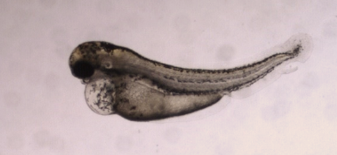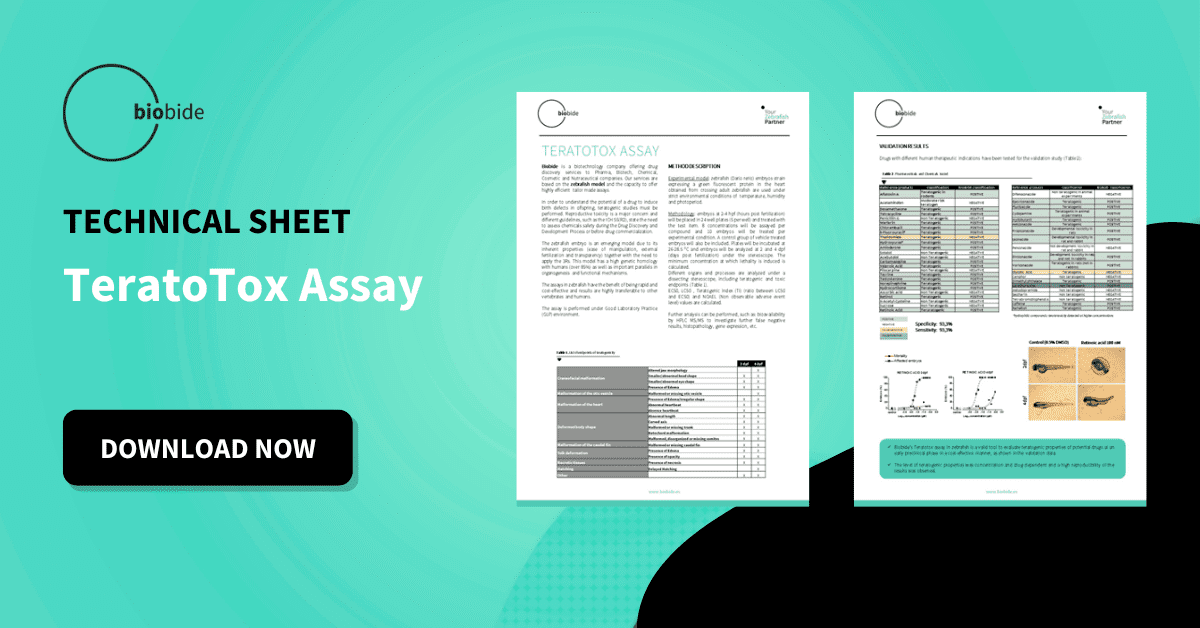Teratogens are substances that can cause physical or functional defects in human embryos or fetuses. Since the Thalidomide medical disaster in the late 1950s and early 1960s, it is mandatory to determine the potential of a drug to induce congenital defects, through teratogenic assays. Moreover, the number of compounds that are required to be tested for teratogenicity has increased greatly in the last years due to the continued development of chemicals used for treatment, cosmetics, or food additives.
Conventional mammalian animal tests for assessing developmental and reproductive toxicity are laborious, costly, and time-consuming. Thus, there is a need for the development of alternative teratogenic assays that compromises cost-effectiveness, adequate throughput, straightforward assay conduct, reproducibility, and concordance with in vivo mammalian data.

In this sense, the zebrafish model is an attractive candidate for screening of developmental toxicity during early Drug Development, as they are cost-effective and easy to maintain, allowing High Content Screening (HCS) of Drug candidates. In addition, zebrafish development is similar to that of mammals, and many molecular pathways are evolutionarily conserved between zebrafish and humans, being highly predictive of mammalian responses. A representative example of a High-Content teratogenicity assay is the Teratotox Assay from Biobide.
Teratogens
Teratogens are substances that can cause developmental defects, physical or functional, in a human embryo or fetus after a pregnant woman is exposed. Exposure to a teratogen may affect the embryo or fetus in several ways, causing physical malformations, problems in behavioral or emotional development, and developmental defects in the nervous system that potentially can cause disability and retardation. Additionally, teratogens may also affect pregnancy and cause complications such as preterm labor, spontaneous abortions, or miscarriages.
One of the most well-known examples of developmental toxicity is the thalidomide controversy of the 1950s. Thalidomide was a drug that was used to treat morning sickness, colds, and flu in pregnant women and was marketed in 46 countries. No tests were performed on pregnant women before the drug was launched, and it was believed to be safe until many children were born deformed. Thalidomide was sold under numerous different brand names and it took over 5 years to identify its adverse impact on the fetus.
As a result, regulation was changed and the Food and Drug Administration (FDA) issued the Reproductive Research Guidance for the Safety Assessment of Human Drugs, creating standards for evaluating teratogenicity. To standardize testing for drugs, the FDA established special classifications, labeled A, B, C, D, and X, which determine the degree of risk associated with using a particular drug during pregnancy. Drugs in categories D and X are those with embryotoxic and/or teratogenic effects on humans and animals. Its homologous in the European Medicines Agency (EMEA) is the reproductive toxicology: detection of toxicity to reproduction for human pharmaceuticals, described in the ICH S5(R3) Guideline, which states the need to assess chemicals safety during the Drug Discovery and Development Process or before Drug commercialization.
Teratogenicity Testing
The preclinical evaluation of drugs traditionally involves large numbers of animals to predict possible drug side effects. Various animal-based test systems established for screening potential teratogenic activity are performed on pregnant laboratory animals, usually mammals such as mice, rats, rabbits, and non-human primates. Test compounds are administered daily during the period of organogenesis of the fetus and near-term the fetus is examined for skeletal, visceral, and external anomalies.
However, such tests are generally expensive and time-consuming, contravening the current need for rapid testing of potential drugs. In addition, there is an increasing demand from both the public and regulatory bodies to reduce animal use (especially the use of mammals) in safety testing, in agreement with the 3Rs (Replacement, Reduction, and Refinement of animals). This policy provides a set of regulations for alternatives to testing in animals, leading to a great need for the development of alternative test systems.
How alternative models can be used?
As an alternative to animal testing, and in compliance with the 3Rs policy, several in vitro models based on a wide range of cells and tissues have been developed for detecting teratogenicity. This includes whole embryo culture tests, organ culture teratogen assays (e.g. micromass teratogen test), as well as eukaryotic cell culture systems (e.g. embryonic stem cell test and Dictyostelium discoideum).
Although in vitro assays using cultured cells can be used to evaluate potential drug and chemical toxicity, results are frequently not predictive of in vivo results that involve drug Absorption, Distribution, Metabolism, and Excretion (ADME).
The use of zebrafish as an alternative animal model for in vivo drug and chemical toxicity assays can greatly increase the speed and decrease the cost of the assessment process, and provide more accurate results than cell-based assays. This animal model possesses many of the advantages of in vitro systems, but being a complete animal can serve as an intermediate step between cell-based evaluation and mammalian animal testing.
Compared to conventional mammal testing, zebrafish offers several compelling experimental advantages, including the small size of embryos; high fertility (over 200 eggs every 2-3 days); rapid embryo development and organogenesis (most of the organs developed by 120 hours post-fertilization- hpf-); shorter test period, lower cost, smaller amount of compound required, easier manipulation, direct compound delivery and scalability for High Content Screening. In addition, experiments can be carried out in embryos during their development until 120 hpf, being under the 3 Rs umbrella and not needing the approval of Ethical Committees. Also, they are transparent at the larval stage so invasive procedures can be avoided.
Furthermore, zebrafish development is similar to that of mammals, and many metabolic pathways are evolutionarily conserved between zebrafish and humans. In particular, it has been shown that zebrafish possess orthologues to the majority (86%) of human drug targets. The zebrafish genome is fully sequenced and is shown to share approximately 85% homology with their human counterparts.
Numerous studies have confirmed that zebrafish and mammals are similar in their physiology, development, metabolism, and pathways and that zebrafish responses to toxic substances are highly predictive of mammalian responses.
Remarkably in 2003, the National Institutes of Health (NIH) ranked the zebrafish as the third most important experimental organism after rats and mice. FDA and EMEA also accepted zebrafish toxicity and safety assessment data for investigative new drug approval. Since the ICH S5 R3 guideline included the option to use alternative models such as zebrafish to elucidate contradictory teratogenic data between the two required screening models, rodents, and rabbits.
In contrast to other vertebrate models, the zebrafish completes embryogenesis in the first 72 h and by 120 hpf it develops discrete organs and tissues. In studies on rats, test compounds are typically exposed from implantation until the closure of the hard palate, during which the main organ formation occurs. In zebrafish, rapid morphogenesis is completed during embryogenesis, a similar stage in the development of rats.
The teratogenic potential of compounds can be predicted quantitatively by a ranking of zebrafish embryos according to a scoring system of phenotypic changes, similar to the morphological assessments performed using the mammalian in vivo embryo-fetal development. Thus, the zebrafish model may support the screening model for teratogenicity as an alternative developmental toxicology model to predict effects in humans. That could be complemented by sperm analysis in the zebrafish model, to obtain also information on spermatogenesis apart from embryo development.
Biobide’s Teratotox Assay
Biobide’s Teratotox Assay in zebrafish is a valid tool to evaluate the teratogenic properties of potential drugs at an early preclinical phase in a High Content format and a cost-effective manner. As previously mentioned, the assays in zebrafish have the benefit of being rapid and cost-effective and results are highly transferable to other vertebrates and humans.
To perform the Teratotox Assay, zebrafish embryos expressing a green fluorescent protein in the heart can be used under strict environmental conditions of temperature, humidity, and photoperiod. Embryos at 2-4 hpf (hours post-fertilization) are placed in 24 well plates and treated with the test compounds. Usually, 5 concentrations are assayed per compound and 10 embryos are treated per experimental condition. Plates are incubated at their preferred temperature and embryos are analyzed at 2 and 4 or 5 dpf (days post-fertilization) under the stereoscope. The minimum concentration at which lethality is induced is calculated.s
Different organs and processes are analyzed under a dissecting stereoscope, including teratogenic and toxic endpoints including malformations, morphological defects, and the presence of edema or necrotic tissue among others. EC50, LC50, Teratogenic Index (TI), and NOAEL values are calculated.
Further analysis like bioavailability can be performed by HPLC-MS/MS technique to investigate the real internal concentration of the test compounds and extrapolate better to other models, but also to discharge false negative or false positive results. Complemented even by histopathology, gene expression, etc.
Sources
- https://biobide.com/portfolio/teratotox-assay
- https://www.hindawi.com/journals/bmri/2013/726478/
- https://www.frontiersin.org/articles/10.3389/fgene.2021.645555/full
- https://embryo.asu.edu/pages/teratogens
- https://journals.plos.org/plosone/article?id=10.1371/journal.pone.0145286
- https://www.ncbi.nlm.nih.gov/pmc/articles/PMC3558154/
- https://www.jstage.jst.go.jp/article/jts/39/3/39_453/_article
- https://www.ncbi.nlm.nih.gov/pmc/articles/PMC7870776/
- https://pubmed.ncbi.nlm.nih.gov/34660207/
- https://onlinelibrary.wiley.com/doi/epdf/10.1002/bdrb.20223
- https://pubmed.ncbi.nlm.nih.gov/29896702/
- https://pubmed.ncbi.nlm.nih.gov/24503215/





